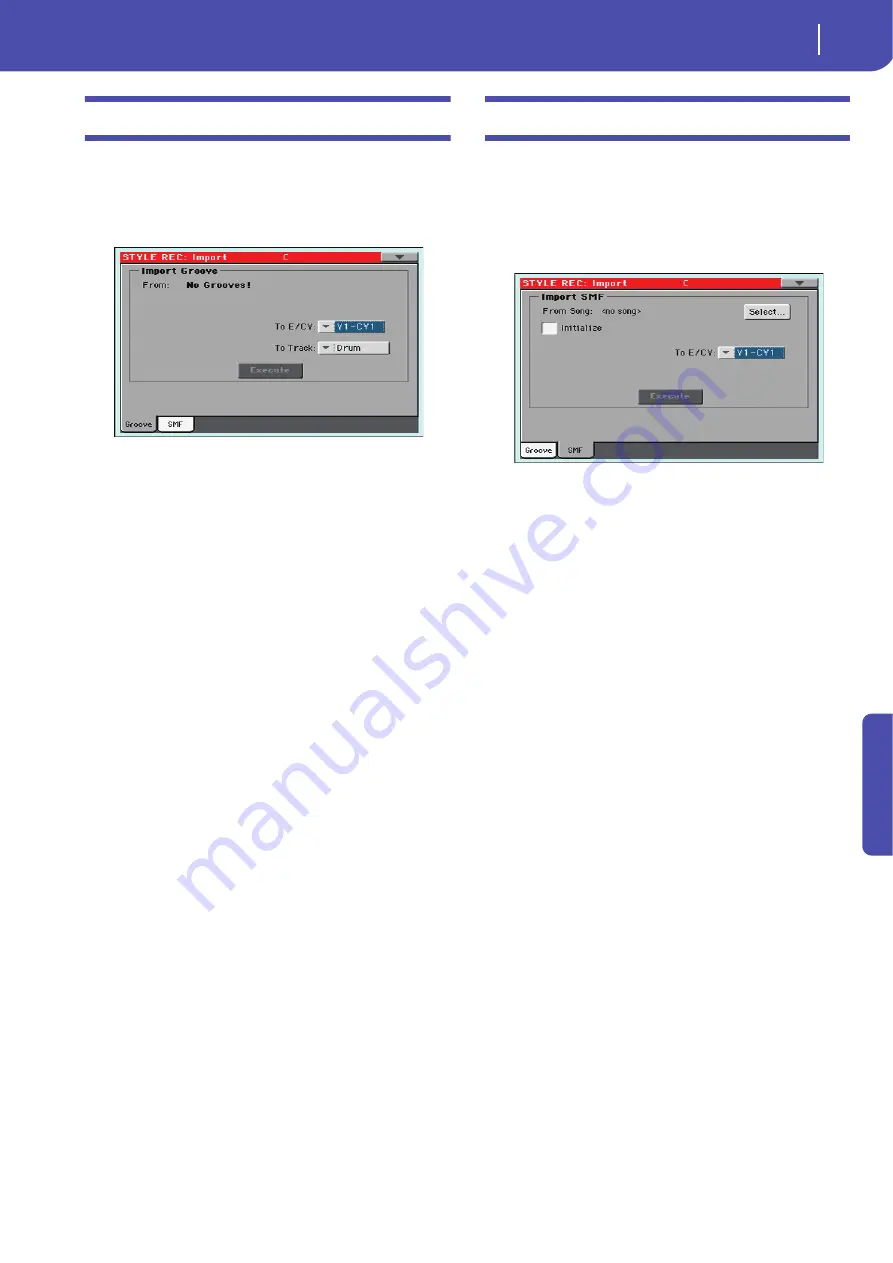
63
Style/Pad Record mode
Import: Import Groove
Re
fe
rence
Import: Import Groove
The Import Groove function allows the loading of MIDI
Grooves (“.GRV” files)). By importing these data to a track, and
assigning the Sound based on the sliced samples to the same
track, you can play the original audio groove, and freely change
its Tempo.
Note:
After importing a groove generated by a melody line (not by
a percussive groove), the imported groove and samples will not be
transposed together with the other Style tracks. Audio data cannot
be transposed by the arranger.
Note:
Please execute the Import Groove operation before turning
the instrument off. All “.GRV” files generated by a Time Slice oper-
ation are deleted when turning the instrument off.
From
Use this parameter to select one of the MIDI Groove patterns
(“.GRV” files) generated when saving data after a Time Slice
operation.
To E/CV (Style Element/Chord Variation)
Use this parameter to select the target Style Element
(Style only)
and Chord Variation.
To Track
(Style only)
Use this parameter to select the target track inside
the selected Chord Variation.
The Percussion track is usually
suggested,
since the Drum track is still suitable for standard
Drum Kit sounds (count-in, break etc.). After importing the
MIDI Groove pattern, assign the Sound, to which the sliced
samples are assigned, to the track playing the MIDI Groove pat-
tern.
Import: Import SMF
The Import SMF function allows you to import MIDI data from
a Standard MIDI File (SMF) created on your preferred external
sequencer, and transform them in a Chord Variation.
Note:
You cannot use this function to import data from any
generic Song. The Standard MIDI File to be imported must be pro-
grammed as if it was one of Pa600’s Chord Variations.
When importing an SMF, parameters like CV Length, Meter,
Tempo Changes, Program Changes and Expression are recog-
nized. These parameters will be imported as the header of the
Style Element containing the Chord Variation, provided the
“Initialize” parameter is checked, or the Style Element is empty.
Hint:
It is a good idea to check the “Initialize” parameter when
importing the first Chord Variation of a Style Element, and
uncheck it when importing the following Chord Variations.
• Sounds assigned to each track can be imported, provided the
Program Change, Bank Select MSB and LSB events are on the
first ‘tick’ of the SMF. These data are loaded in the Style Ele-
ment’s header, and not as Sounds assigned to the Style Perfor-
mance.
Note:
Sounds in the Style Element header can be overridden by
Sounds assigned to the Style Settings, by checking the “Original
Style Sound” parameter in the main page of the Style Play mode
(Style Track view).
• If the above data was not found on the first ‘tick’ of the
imported SMF, Sounds must be manually assigned to each track.
You can do this in the “Record 1” or “Record 2”, or the “Sound/
Expression” page of the Style Record mode,.
• Key/Chord, Chord Table, Expression, and any other Style Vari-
ation parameter, must be manually programmed in the relevant
Style Record pages.
• The starting Tempo, and each track’s Volume, must be pro-
grammed as Style Settings data, and then saved in the Style Set-
tings.
• Meter (time signature) Change is not allowed, therefore not
recognized.
• The Chord Variation length is the same as the imported SMF.
You can change length by changing the value of the CV Length
parameter, on the main page of the Style/Pad Record mode.
Summary of Contents for PA 600 QT
Page 1: ...Reference Guide ENGLISH OS Ver 1 0 1 E ...
Page 2: ......
Page 8: ...4 Table of Contents ...
Page 9: ......
Page 196: ...192 MIDI Playing another instrument with Pa600 ...
Page 197: ......
Page 327: ......
















































